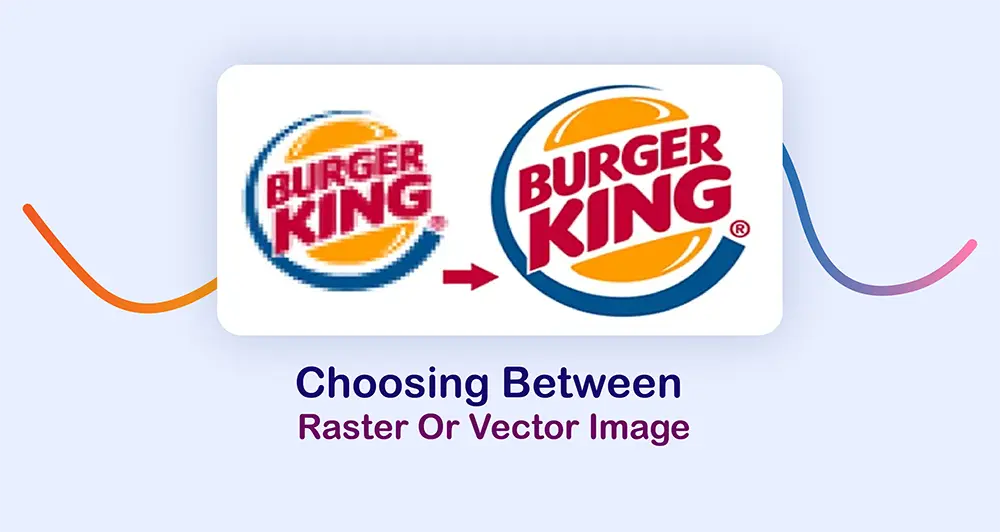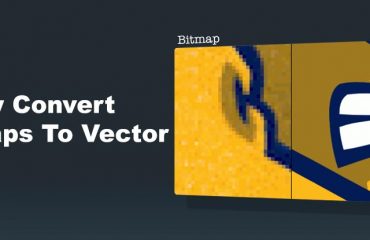
>> What you’ll learn in this article
ToggleThe choice between raster and vector images revolves around their distinct characteristics, suitability for different purposes, and the specific needs of the project.
Raster Images:
Raster images are a fundamental type of digital image composed of individual pixels arranged in a grid. Understanding their characteristics, applications, advantages, and limitations is crucial in comprehending their role in digital media, photography, and various industries.
Characteristics of Raster Images:
Pixel-Based Composition:
Raster images also referred to as bitmap images, are created using a grid of tiny pixels, with each pixel storing specific color information. When viewed together, these pixels form the visual representation of the image.
Resolution Dependency:
One of the most significant aspects of raster images is their resolution dependency. These images have a fixed number of pixels, known as their native resolution, determined at their creation. When enlarged or zoomed in, raster images can lose quality because they lack the additional pixels needed for higher resolutions. This leads to pixelation or blurriness as the existing pixels are stretched to fill the larger space.
Common File Formats:
Raster images come in various file formats such as JPEG, PNG, GIF, TIFF, and BMP, each with its unique features, compression methods, transparency support, and suitability for different types of images.
Detail Representation:
Raster images excel at representing complex images, photographs, and graphics requiring fine details, shades, color variations, and intricate textures. They capture the subtleties present in photographs or highly detailed visuals with precision.
Uses of Raster Images:
Photography and Detailed Graphics:
In the realm of photography, raster images play a pivotal role in capturing the richness of detail, color depth, textures, and nuances present in visual compositions. They are also widely used in graphic design, digital art, and illustrations where intricate details and realistic representation are crucial.
Web and Digital Media:
Raster images find extensive application in web design, social media, digital advertising, and online platforms where high-quality, detailed visuals are essential. They enhance the visual appeal of websites, social media posts, and digital marketing materials.
Advantages of Raster Images:
Realistic Detail:
The strength of raster images lies in their ability to capture the intricate details, textures, and color variations present in photographs and complex graphics, resulting in a more realistic representation.
Versatility:
Raster images are compatible with a wide range of software and devices, making them versatile and accessible for various applications across industries.
Limitations of Raster Images:
Resolution Constraints:
The resolution dependence of raster images limits their scalability. Enlarging or zooming in on raster images beyond their native resolution can lead to a loss of quality, resulting in pixelation or blurriness.
File Size and Storage:
High-resolution or detailed raster images can result in larger file sizes, impacting storage requirements and potentially causing longer load times on websites or digital platforms.
Conclusion:
Raster images, constructed with individual pixels forming a grid, are essential in capturing rich details, textures, and color depth present in photographs and detailed graphics. While they excel at representing realistic details, their limitations in terms of resolution dependency and scalability should be considered when choosing the appropriate image format for specific applications. Raster images are highly versatile and extensively used in photography, digital media, web design, and various industries requiring high-quality, detailed visuals. Understanding the characteristics and applications of raster images is vital for leveraging their strengths and addressing their limitations effectively across diverse platforms and industries.
Vector Images:
Let’s delve deeper into the world of vector images, covering their characteristics, creation process, uses, advantages, limitations, and significance across various industries.
Characteristics of Vector Images:
Mathematical Construction:
Vector images are created using mathematical formulas that define geometric shapes, lines, curves, and colors. Instead of pixels, they use mathematical equations to represent graphic elements.
Resolution Independence:
A defining feature of vector graphics is their resolution independence. As they are based on mathematical formulas rather than a fixed grid of pixels, they can be scaled infinitely without losing sharpness or clarity. This scalability makes them versatile for various applications and sizes.
File Formats:
Common file formats for vector images include SVG (Scalable Vector Graphics), AI (Adobe Illustrator), EPS (Encapsulated PostScript), and PDF (Portable Document Format). These formats support vector graphics and maintain their scalability and editability across different platforms and software.
Precision and Editability:
Vector images offer precise control over shapes, lines, colors, and elements. They are easily editable, allowing for manipulation, modification, and adjustment of graphic components without loss of quality.
Creation Process of Vector Images:
Vector Drawing Tools:
Specialized software like Adobe Illustrator, CorelDRAW, Inkscape, or vector drawing tools within design applications are used to create vector images. These tools offer functionalities such as pen tools, shapes, and anchor points for creating and editing vector graphics.
Object-Oriented Approach:
Vector images are created using an object-oriented approach, where elements are defined as objects composed of lines, shapes, curves, and text. Each object can be individually manipulated without affecting other parts of the image.
Curves and Paths:
Paths defined by mathematical equations form the basis of vector images. Curves, lines, and shapes are represented by these paths, enabling designers to modify shapes by adjusting anchor points and curves.
Uses of Vector Images:
Logos and Branding:
Due to their scalability and precise representation, vector graphics are commonly used for logos, icons, and branding elements. They maintain quality across various sizes and applications, ensuring brand consistency.
Illustrations and Design:
Designers often use vector graphics for illustrations, icons, typography, infographics, and various design elements requiring clean lines, sharp edges, and scalable graphics.
Print Materials:
Vector images are extensively used in print materials like brochures, flyers, posters, and banners. Their ability to maintain quality in different print sizes is advantageous for high-quality print production.
Advantages of Vector Images:
Infinite Scalability:
Vector graphics can be scaled infinitely without losing quality, making them ideal for various applications across different sizes and resolutions.
Editability and Flexibility:
Vector images are easily editable, allowing designers to modify, rearrange, or resize individual elements without degradation in quality. This flexibility aids in design iterations and modifications.
Limitations of Vector Images:
Complexity in Detail Representation:
Vector graphics may not excel in representing highly detailed textures, complex gradients, or photographic realism due to their emphasis on clean lines and shapes.
Software and Compatibility:
Not all software or applications support vector formats equally, which may limit their universal use in certain contexts.
Conclusion:
Vector images, constructed using mathematical formulas to define shapes and elements, are essential in design, illustration, branding, and various industries. Their resolution independence, scalability, precision, and versatility make them invaluable for creating graphics that maintain quality across different sizes and applications. While they excel in scalability, precision, and editability, they may not be the best choice for highly detailed textures or complex photographic representations. Understanding the characteristics, creation process, uses, advantages, and limitations of vector images is crucial for leveraging their strengths effectively in diverse design and illustration contexts.
Choosing Between Raster or Vector:
The choice between raster and vector graphics depends on various factors, each format having its distinct characteristics, ideal use cases, advantages, and limitations. Understanding these differences is crucial in selecting the most suitable format for a particular project or application.
Raster Images:
Characteristics:
- Pixel-based: Comprised of a grid of individual pixels, each storing color information to form the image.
- Resolution-dependent: Quality is fixed at a specific resolution, and enlarging the image can lead to a loss in quality known as pixelation or blurriness.
- File Formats: Common formats include JPEG, PNG, GIF, TIFF, and BMP.
- Detail Representation: Well-suited for photographs, complex images, and graphics requiring intricate details, shades, and color variations.
Best Suited for:
- Photography: Ideal for capturing the richness of detail, color depth, and textures present in photographs.
- Web-Based Graphics: Widely used in web design, social media, and digital media where realistic and detailed visuals are essential.
Advantages:
- Realistic Detail: Excellent for capturing nuanced details, textures, and color variations present in photographs and complex graphics.
- Versatility: Compatible with most software and devices, making them accessible for various applications.
Limitations:
- Resolution Dependency: Scaling beyond the native resolution can lead to a loss in quality and pixelation.
- File Size and Storage: Images with high resolution or extensive detail can result in larger file sizes, impacting storage and load times.
Vector Images:
Characteristics:
- Mathematically Constructed: Defined using mathematical formulas to represent shapes, lines, curves, and colors.
- Resolution-independent: Infinitely scalable without any loss of quality or sharpness.
- File Formats: Common formats include SVG, AI, EPS, and PDF.
- Precision and Editability: Offers precise control over shapes, lines, colors, and elements, and is easily editable.
Best Suited for:
- Logos and Branding: Ideal for designs requiring scalability and precise representation, such as logos and branding elements.
- Illustrations and Design: Used for graphics, typography, and design elements requiring clean lines and scalability.
Advantages:
- Infinite Scalability: Can be scaled to any size without losing quality, ensuring consistency across various applications.
- Editability and Flexibility: Easily editable, allowing for manipulation and modification without any degradation in quality.
Limitations:
- Complex Detail Representation: May not excel in representing highly detailed textures or complex photographic realism.
- Software Compatibility: Not universally supported by all software or applications.
Choosing Between Raster or Vector:
Consider Raster If:
- Photographic Detail: Working with photographs or images with fine details requiring realistic representation.
- Web-Based Graphics: Focused on digital media, web design, or social media where high-detail visuals are crucial.
Consider Vector If:
- Scalability is Key: Requiring designs that scale without loss of quality, such as logos and print materials.
- Clean Graphics: Working with clean lines, simple shapes, or graphics needing easy scalability and editability.
Conclusion:
Both raster and vector graphics offer unique advantages and are suited for different purposes. Raster images excel in capturing detailed photographic realism and are versatile in web-based graphics. On the other hand, vector images provide scalability, precision, and editability, making them ideal for clean, scalable designs like logos and illustrations. The choice between raster or vector graphics ultimately depends on the specific needs of the project, considering factors like intended use, scalability requirements, and the level of detail desired. Understanding the strengths and limitations of each format is crucial in making an informed decision for optimal results in design and illustration contexts.

